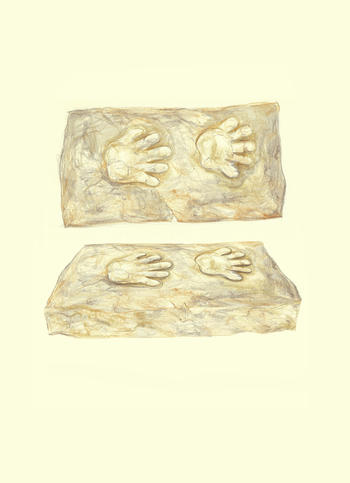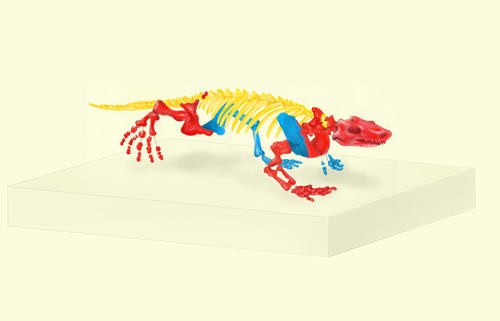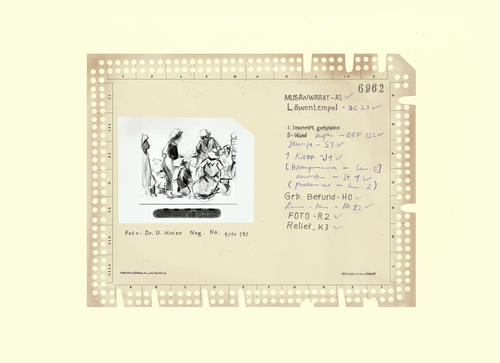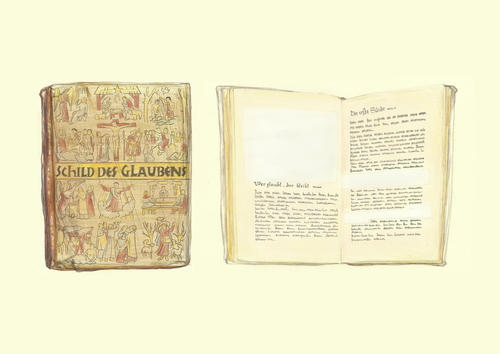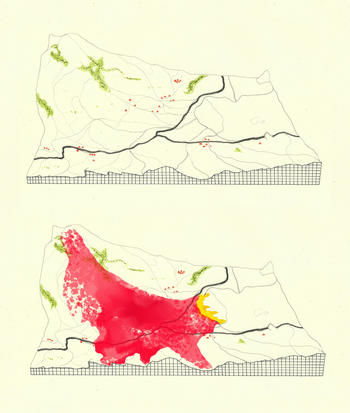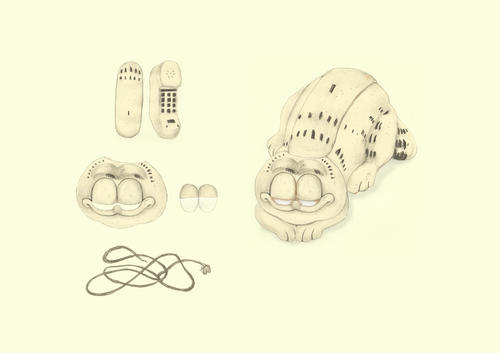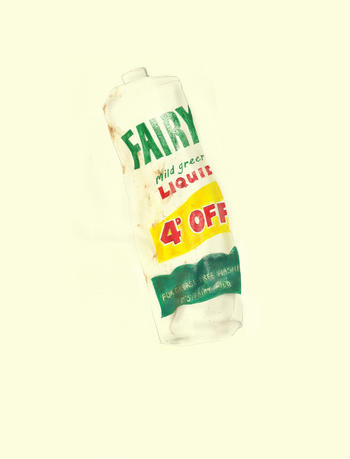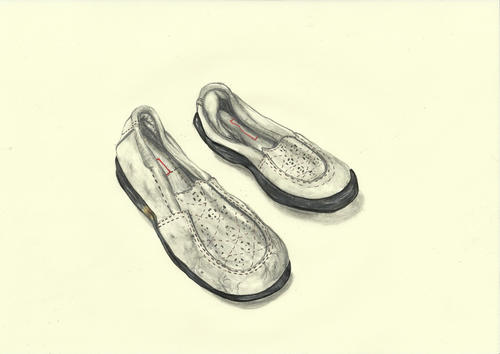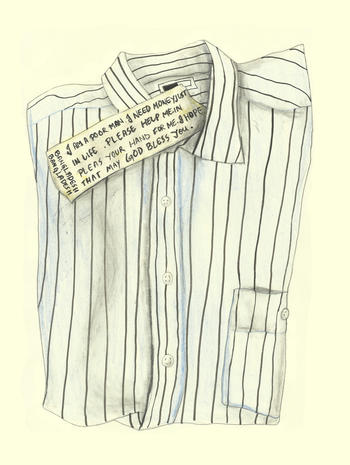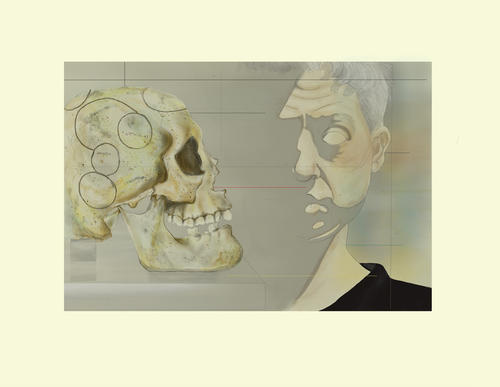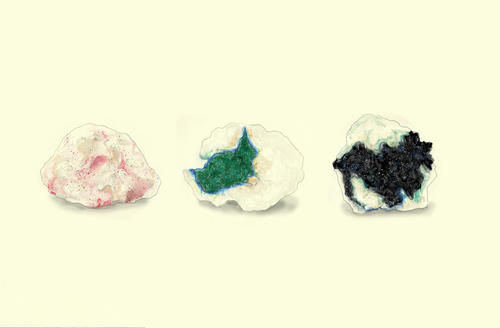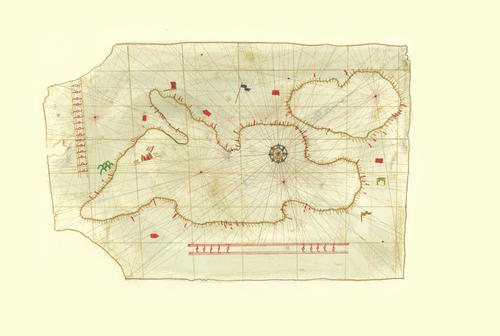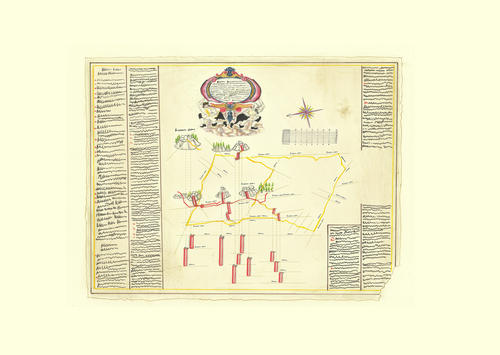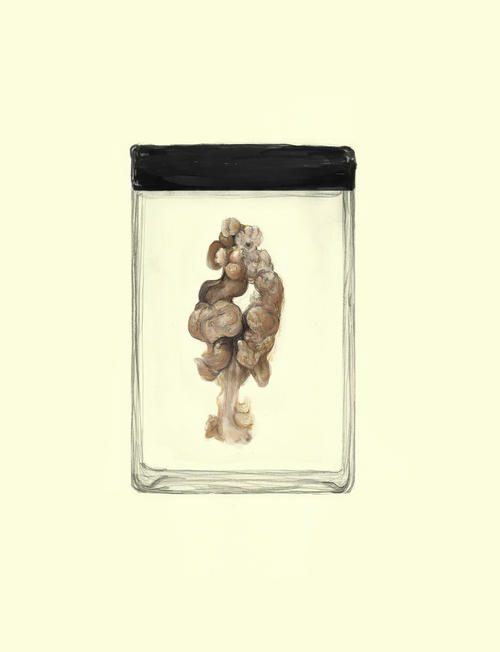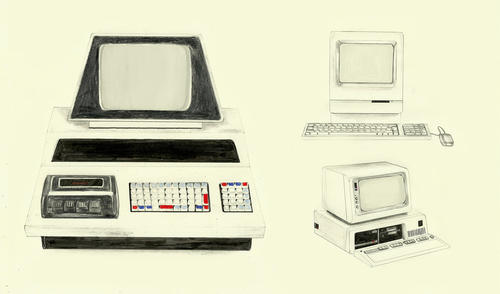OVERTEXTED
Literature as Intermedial Practice
An audio exhibition of the Cluster of Excellence "Temporal Communities: Doing Literature in a Global Perspective" at Freie Universität Berlin at the Humboldt Labor
ENGLISH | DEUTSCH
Introduction
"Zugetextet" is an audio exhibition of the Cluster of Excellence EXC 2020 "Temporal Communities: Doing Literature in a Global Perspective" (Freie Universität Berlin), which was created in cooperation with the Humboldt Labor at Humboldt Forum. Part of the exhibition "After Nature", which opened July 20, 2021, the audio tour enters into a dialogue with selected objects from the collections of Humboldt-Universität zu Berlin and other universities.
In 15 audio contributions, the scholars of the Cluster trace the objects' material and theoretical layers of meaning and make connections between text and object, material and context.
Drawings by the artist Josua Josua make the audio tour's exhibits visible online, framed by quotes from the respective audio tracks.
Fossil footprints of an Orobates pabsti
A contribution by
Petra Wodtke, Research Area 2: "Travelling Matters"
and
Simon Godart, Research Area 3: "Future Perfect"
When Michael Crichton’s novel "Jurassic Park" was published and adapted as a Hollywood movie in the 1990s, the idea of bringing dinosaurs to life from a mosquito trapped in amber sparked a hype. Petra Wodtke and Simon Godart talk about the complex temporality of the 300-million-year-old tracks of Orobates pabsti, a diadectid, which tells a story not unlike the dinosaur tracks in the novel and the model of the reptile's skeleton which is also to be found in this exhibition.
» The group walked on, following a dirt path through a dense bamboo grove. At the far side, they came to a double-layer chain-link fence twelve feet high, with spirals of barbed wire at the top.
There was an electric hum along the outer fence. Beyond the fences, Grant saw dense clusters of large ferns, five feet high. He heard a snorting sound, a kind of snuffling.
Then the sound of crunching footsteps, coming closer.
[…] a long silence.
›I don’t see anything,‹ Tim whispered, finally.
›Ssssh.‹
Grant waited. Several seconds passed. Flies buzzed in the air. He still saw nothing.
Ellie tapped him on the shoulder, and pointed.
Amid the ferns, Grant saw the head of an animal. It was motionless, partially hidden in the fronds, the two large dark eyes watching them coldly.
The head was two feet long. From a pointed snout, a long row of teeth ran back to the hole of the auditory meatus which served as an ear. The head reminded him of a large lizard, or perhaps a crocodile. The eyes did not blink, and the animal did not move. Its skin was leathery, with a pebbled texture, and basically the same coloration as the infant’s: yellow-brown with darker reddish markings, like the stripes of a tiger.
As Grant watched, a single forelimb reached up very slowly to part the ferns beside the animal’s face. The limb, Grant saw, was strongly muscled. The hand had three grasping fingers, each ending in curved claws. The hand gently, slowly, pushed aside the ferns.
Grant felt a chill and thought, He’s hunting us. «
From: Michael Crichton: Jurassic Park. New York: Ballantine, 2015. p. 130.
Original object: Fossil footprint of an Orobates pabsti
Date: Pliocene (c. 300 million years old)
Medium/Material: Cast/Stone
Dimensions: 14 x 45 x 19 cm
Collection: Humboldt-Universität zu Berlin/Humboldt-Forum
3D print of an Orobates pabsti
A contribution by
Dustin Breitenwischer, Research Area 1: "Competing Communities"
and
Petra Wodtke, Research Area 2: "Travelling Matters"
In their audio contribution on 3D printing, Dustin Breitenwischer and Petra Wodtke discuss the reconstructive formation of a fossilised skeleton and the connections that Dustin Breitenwischer draws between the multiple transformations of this object and Franz Kafka’s story "The Metamorphosis."
» As Gregor Samsa woke one morning from uneasy dreams, he found himself transformed into some kind of monstrous vermin. He lay on his hard, armour-like back, and if he lifted his head a little, he could see his curved brown abdomen, divided by arch-shaped ridges, and domed so high that the bedspread, on the brink of slipping off, could hardly stay put. His many legs, miserably thin in comparison with his size otherwise, flickered helplessly before his eyes. ›What has happened to me?‹ he thought. It was not a dream. «
From: Franz Kafka: "The Metamorphosis." The Metamorphosis and Other Stories, translated by Joyce Crick, Oxford & New York: Oxford University Press, 2009, p. 29.
Original object: 3D print of an Orobates pabsti
Date: 2016
Material: Plastic
Dimensions: 68 x 13 x 26 cm
Collection: Stiftung Schloss Friedenstein Gotha
Punch card
A contribution by
Lindsey Drury, Research Area 5: "Building Digital Communities"
and
Bart Soethaert, Research Area 5: "Building Digital Communities"
The conversation between Lindsey Drury and Bart Soethaert, which starts with an IBM punch card, explores the human work behind processing digital data. The punch card tells a story of the data’s materiality and the intricate intertwining of technology, formalisation and application that takes place when data is processed.
» Punch cards could only be designed, printed, and purchased from one source: IBM. The machines were not sold, they were leased, and regularly maintained and upgraded by only one source: IBM. IBM subsidiaries trained the Nazi officers and their surrogates throughout Europe, set up branch offices and local dealerships throughout Nazi Europe staffed by a revolving door of IBM employees, and scoured paper mills to produce as many as 1.5 billion punch cards a year in Germany alone. Moreover, the fragile machines were serviced on site about once per month, even when that site was in or near a concentration camp. [...] IBM NY officials, and frequently [Thomas] Watson’s personal representatives, Harrison Chauncey and Werner Lier, were almost constantly in Berlin or Geneva, monitoring activities, ensuring that the parent company in New York was not cut out of any of the profits or business opportunities Nazism presented. When U.S. law made such direct contact illegal, IBM’s Swiss office became the nexus, providing the New York office continuous information and credible deniability.
Used for racial redlining in the United States in the same years when it was used by Nazis in the Holocaust, the thick paper of punch cards was the first computer data storage. Thus, the computer was at first a paper-based medium, and its seemingly simple cards could facilitate extreme acts of violence.
[...] «
From: Edwin Black: IBM and the Holocaust. The Strategic Alliance between Nazi Germany and America’s Most Powerful Corporation. Washington, DC: Dialog Press, 2012, pp. 9-10.
Original object: Punch card
Date: 1960-1970
Material: Paper
Dimensions: 21 x 30 cm
Collection: Humboldt-Universität zu Berlin, Sudanarchäologische Sammlung & Archiv
Children’s Bible
A contribution by
Jasmin Wrobel, Research Area 4: "Literary Currencies"
and
Petra Wodtke, Research Area 2: "Travelling Matters"
In conversation with Petra Wodtke, Jasmin Wrobel takes a close look at a children’s Bible ("Shield of Faith") from the cult community Colonia Dignidad. She shows how the exhibit, which suggests protection and piety, displays a paradoxical relationship to the serious crimes and human rights violations that were committed at Colonia Dignidad.
» One day I was sitting at my small table in the bakery doing my schoolwork. Suddenly, the women ran out cheering. Tío drove up. He’d been with the boys at the goldmine for the three summer months. Now he came straight to the bakery. What happiness! He walked in, but I didn’t move from where I was and looked neither right nor left. Tío greeted everyone with Grüß Gott, ›Good Day‹. I stayed seated. Tío approached me, bent down and said: ›And you? You don’t want to say hello to me?‹ And I said: ›No!‹ Tío: ›Is that so! Why not then?‹ I answered: ›Because I’m afraid of you.‹ Tío: ›Oh, you’re afraid of me?‹ ›Yes, I am afraid of you!‹ Unfortunately, I was always like that: said exactly what I felt, as children do. Then he said to me: ›Alright then, I’ll give you a reason to be afraid of me – we’re going to give you a good spanking!‹ He called his sprinter and simply gave him the order: ›Beat her up!‹ He gave no explanation, nothing. The sprinter immediately started to strike me, hitting my behind with a crumb brush. I fell over, but Tío picked me up, squeezed me between his legs while the sprinter carried on with his beating. Finally, he let me go and yelled: ›Now you have a reason to be afraid of me! Do you get it now?‹ I just nodded, wanted to sit down but my backside was hurting too much. I couldn’t sit! I couldn’t sleep; I just lay on my tummy and held my aching bones. I’d been beaten black and blue. «
From: Eva Maria Laube Laib: "Eva Maria Laube Laib erinnert sich." Lasst uns reden: Frauenprotokolle aus der Colonia Dignidad, ed. Heike Rittel & Jürgen Kawelat, Stuttgart: Schmetterling, 2018, p. 65. English translation by Martin Bleisteiner & Rebecca van Es.
Original object: Children’s bible
Date: 1957
Material: Paper
Dimensions: 21,6 x 30,8 x < 3 cm
Collection: Private
Relief models of the Goldau rock avalanche
A contribution by
Simon Godart, Research Area 3: "Future Perfect"
and
Dustin Breitenwischer, Research Area 1: "Competing Communities"
In his audio contribution on the landslide model, Simon Godart talks to Dustin Breitenwischer about the objectifying and preserving function of model representations and the difficulty of expressing temporalities via the landscape model. Viewed in conjunction with eyewitness accounts of the Goldau landslide, it becomes clear how representations of this disaster are influenced and prefigured by literary narratives.
» Quaeque ipsa miserrima vidi,
Et quorum pars magna fui.
I have seen misery
and I was a big part of it.
Virgil, Aeneid.
It falls to me to describe the wretched misery that I have seen, and for which I felt so much pity. Who could hold back the tears when telling such a tale? Alas! And so I am compelled to begin with Virgil, who puts this lament into the mouth of Aeneas before he strikes up his song of Troy’s destruction – words that I, too, feel justified in using as a preface to the horrible account that must follow. For the 2nd of the autumn month of 1806 would go down in the chronicles of Switzerland as a date of terrible memory. On this day, an awful fate befell one of the loveliest pastoral vales of Helvetia, annihilating in the most gruesome fashion more than 300 buildings and an even higher number of the worthiest people, and plunging into deep mourning not only the region immediately affected, the canton of Schwyz, but also our common fatherland and all the nobler parts of mankind; the municipality of Arth, in particular, suffered wounds which centuries will not suffice to heal. As sad and dreadful as the story may be, so worthy of attention, nay, so imperative, is its telling; and so beneficial may this telling prove in the future. «
From: Karl Zay: Goldau und seine Gegend. wie sie war und was sie geworden, in Zeichnungen und Beschreibungen, zur Unterstützung der Übriggebliebenen Leidenden in den Druck gegeben. Zürich: Orell, Füßli & Compagnie, 1807, pp. V-VI. English translation by Martin Bleisteiner & Rebecca van Es. (Sogenanntes Schuttbuch).
Original object: Relief models of the Goldau rock avalanche in 1806
Date: 1809
Collection: Humboldt- Universität zu Berlin, Geographisches Institut
Dimensions: 107 x 60 x 27cm
Plastic flotsam and jetsam "Garfield telephone"
A contribution by
Lindsey Drury, Research Area 5: "Building Digital Communities"
and
Jasmin Wrobel, Research Area 4: "Literary Currencies"
In their contribution, Lindsey Drury and Jasmin Wrobel discuss the link between Western consumer culture and media phenomena. They reflect on the Garfield telephone as a circulating, mass-produced commodity polluting the oceans, thus turning into a floating metaphor for the destruction of the environment caused by globalisation.
» A ship with a number of cats on board, abandoned by its crew, ran aground on a desert island, whereupon the cats jumped ashore. «
From: Peter Wessel Zapffe: "The Parable of the Cats." translated by Peder Anker, Terra Nova, vol. 2, no. 1, 1997, p. 152.
Original object: Garfield phone
Date: 1980s
Material: Plastic, mixed material
Collection: Private, France
Plastic flotsam and jetsam “Fairy Liquid”
A contribution by
Dustin Breitenwischer, Research Area 1: "Competing Communities"
Dustin Breitenwischer sees the mythical dimension of our daily narrative in the "Fairy Liquid" bottle. As a material object, the bottle of washing-up liquid is not just a bearer of a gendered and sexist culture of advertising, it is also a toxic exponent of the flood of plastic covering the planet, which affects contemporary societies in diverse and far from fairy tale-like ways.
"Fairies" by Langston Hughes, 1921
Out of the dust of dreams
Fairies weave their garments.
Out of the purple and rose of old memories
They make rainbow wings.
No wonder we find them such marvellous things.
"After Many Springs" by Langston Hughes, 1922
Now,
In June,
When the night is a vast softness
Filled with blue stars,
And broken shafts of moon-glimmer
Fall upon the earth,
Am I too old to see the fairies dance?
I cannot find them anymore.
From: Langston Hughes: "Fairies." & "After Many Springs." The Collected Poems of Langston Hughes, ed. Arnold Rampersad, New York: Vintage Classics, 1995, p. 597 & p. 28.
Original object: Empty bottle "Fairy Liquid"
Material: Plastic
Date: Before 15 January 1971
Dimensions: 20,5 x 8 x 6 cm
Women's shoes
A contribution by
Jasmin Wrobel, Research Area 4: "Literary Currencies"
In her contribution Jasmin Wrobel relates the shoes of a female refugee to the verses of the cultural theorist and Chicana activist Gloria Anzaldúa. This contextualisation interweaves the debate around the violent anonymisation of people attempting to cross the border between Mexico and the USA with reflections on the (colonial) construction of borders, which forcibly overwrote existing social and legal orders.
» I walk through the hole in the fence
to the other side.
Under my fingers I feel the gritty wire
rusted by 139 years
of the salty breath of the sea.
Beneath the iron sky
Mexican children kick their soccer ball across,
run after it, entering the U.S.
I press my hand to the steel curtain –
chainlink fence crowned with rolled barbed wire –
rippling from the sea where Tijuana touches San Diego
unrolling over mountains and plains
and deserts,
this “Tortilla Curtain” turning into el río Grande
flowing down to the flatlands
of the Magic Valley of South Texas
its mouth emptying into the Gulf.
1,950 mile-long open wound
dividing a pueblo, a culture,
running down the length of my body,
staking fence rods in my flesh,
splits me splits me
me raja me raja
This is my home
this thin edge of
barbwire.
But the skin of the earth is seamless.
The sea cannot be fenced,
el mar does not stop at borders.
To show the white man what she thought of his
arrogance,
Yemayá blew that wire fence down.
This land was Mexican once,
was Indian always
and is.
And will be again.
[…]. «
From: Gloria Anzaldúa: Borderlands/La Frontera. The New Mestiza. San Francisco: Spinsters/Aunt Lute, 32007, pp. 24-25.
Original object: Women's shoes
Date: recent
Dimensions: ca. 10 x 11 x 26 cm (per shoe)
Collection: Private
Cardboard Strip with a Call for Help from Bangladesh
A contribution by
Jasmin Wrobel, Research Area 4: "Literary Currencies"
Jasmin Wrobel discusses a piece of textile, which serves as material visualisation of the multiple forms of violence that go hand in hand with colonialism and globalisation. The call for help from Bangladesh sewn into a shirt marks the effects of structural exploitation and devaluation processes, the traces of which are erased from the global chain of production and trade.
Many major fashion companies have published declarations against exploitation and modern slavery. The following statement was issued by Primark in 2018:
» Our commitment to fighting modern slavery
At Primark, we believe that business can be a force for good if it acts responsibly towards those within its supply chain. We consider modern slavery to be one of the most salient risks within the global garment and textile sector and are committed to preventing and addressing modern slavery in line with the UN Guiding Principles on Business and Human Rights.
Collaboration
Primark continues to work with international and local partners to expand its leverage and influence. We strive to make a positive impact on all the lives we touch. «
From: Primark Ltd. Modern Slavery Statement 2018, primark.a.bigcontent.io/v1/static/Primark-MSA-Statement-2018, pp. 2-3. accessed 19. Oct. 2020.
Original object: Cardboard strip with a call for help from Bangladesh 2005
Date: 2005
Collection: Private
Who is ID 8470?
A contribution by
Anna Degler, Research Area 2: "Travelling Matters"
and
Tal Adler, artist and researcher at the "Centre for Anthropological Research on Museums and Heritage (CARMAH)"
» In Rome, in the Capuchin church, [...] the walls and ceilings are covered with a decorative ossuary in which bones replaced pebbles or shells. A few skeletons, such as those of three small Barberini children, have been reconstructed with remarkable success. Elsewhere, each bone is used according to its shape: Pelvic bones are arranged in rosettes, skulls are stacked in columns, tibias or limbs support the arches of niches, vertebrae form garlands or serve as candlesticks. The work is attributed to an eighteenth-century monk. Here the charnel is no longer merely a repository; it is a stage set in which the human bone lends itself to all the convulsions of baroque or rococo art. The skeleton is exhibited as a theatrical prop and itself becomes a spectacle. Of course, it does not have the vegetative life that seems to persist in the mummy; it has lost its individuality. It is a collective life that animates this decor through the grinning mouths of hundreds of heads, the gestures of thousands of limbs. «
From: Philippe Ariès: The Hour of Our Death: The Classic History of Western Attitudes Toward Death over the Last One Thousand Years. Translated by Helen Weaver, New York: Vintage, 2008, p. 384.
Original object: Artwork by Tal Adler: Who is ID8470?
Collection: Artist's collection
Minerals
A contribution by
Simon Godart, Research Area 3: "Future Perfect"
Simon Godart’s contribution marks the material connections of the exhibited rocks to German colonialism with its concomitant violent crimes. As fragments from copper deposits from today’s Namibia are juxtaposed with the autobiographical testimonies of Andreas Kukuri, these glimmering rocks bear witness to the exploitation of natural resources, to forced labour and the genocide of the Herero.
Original objects: Minerals from the Tsumeb mine, Namibia
Date: c. 1900
Collection: Bundesamt für Geowissenschaften und Rohstoffe, Berlin
Portolan chart
A contribution by
Anna Degler, Research Area 2: "Travelling Matters"
and
Simon Godart, Research Area 3: "Future Perfect"
In their audio contribution on the portolan chart, Anna Degler and Simon Godart discuss maps and their mostly silent claim to truth and objectivity of representation. Their reading of the portolan chart illustrates that maps do not merely convey an image of the world but also (re)produce worldviews. Beyond its legibility, the chart stands for the medial configuration of a claim to power, intertwining cartographic measurements, appropriation and interpretative power.
» […] maps are both instruments and signifiers of spatialization. Geographical maps can, but need not, be fetishes in the sense of appearing to be nontropic, metaphor-free representations, more or less accurate, of previously existing, ›real‹ properties of a world that are waiting patiently to be plotted. Instead, maps are models of worlds crafted through and for specific practices of intervening and particular ways of life. «
From: Donna Haraway: Modest_Witness@Second_Millennium. FemaleMan©_Meets_OncoMouseTM. Feminism and Technoscience. New York & London: Routledge, 1997, p. 135.
Original object: Portolan chart
Material: Parchment
Date: Before 1453
Dimensions: 59 x 91 cm
Statutory mine map
A contribution by
Simon Godart, Research Area 3: "Future Perfect"
and
Anna Degler, Research Area 2: "Travelling Matters"
Simon Godart and Anna Degler discuss the intertwining of myth and technical, legal functionality. A mine plan places the trained observer within a schematically depicted mine, marks ore deposits and records spatial relationships. At the same time, this image of the underworld, with its focus on technical aspects, is steeped in persistent metaphors, containing biblical traits as well as traces of Greek mythology.
» La nature, non contente des merveilles qu’elle opere à la surface de la terre & au-dessus de nos têtes, a encore voulu nous amasser des trésors sous nos piés. Le prix que les hommes ont attaché aux métaux, joint aux besoins qu’ils en ont, leur ont fait imaginer toutes sortes de moyens pour se les procurer. En vain la Providence avoit-elle caché des richesses dans les profondeurs de la terre ; en vain les a-t-elle enveloppées dans les rochers les plus durs & les plus inaccessibles, le desir de les posséder a su vaincre ces obstacles, & ce motif a été assez puissant pour entreprendre des travaux très-pénibles malgré l'incertitude du succès.
Nature, not content with the wonders she has wrought on the surface of the earth and above our heads, has also seen fit to amass treasures for us beneath our feet. The price that men have attached to metals, together with their need for them, has caused all kinds of means to be invented to obtain them. In vain has Providence hidden these riches in the depths of the earth; in vain has she enveloped them in the hardest and most inaccessible rocks. The desire to possess them has found ways to overcome these obstacles, and this motive has proven powerful enough for the most strenuous exertions to be undertaken despite the uncertainty of success. «
From: Paul-Henri Thiry Baron d‘Holbach: "Mines", Encyclopédie, ed. Denis Diderot & Jean le Rond d’Alembert, Paris: Le Breton (et. al.), 1751, p. 523. English translation by Martin Bleisteiner & Rebecca van Es
Original object: Grund und Sayger Riß von gelobten Lande und Grünen Zweyger Fundgrube
Material: Drawing on paper
Date: Before 1740
Dimensions: 82 x 59 cm
Collection: TU Bergakademie Freiberg, Universitätsbibliothek
Appendix of Friedrich Ebert
A contribution by
Petra Wodtke, Research Area 2: "Travelling Matters"
and
Jasmin Wrobel, Research Area 4: "Literary Currencies"
In conversation with Jasmin Wrobel, Petra Wodtke unfolds the layers of meaning contained within the appendix of the former Reich President Friedrich Ebert. This anatomical specimen reveals to the scientific gaze stories about scientific practice, the ethics of showing and the connection between this act of preservation and the political structure of the Weimar Republic.
» Third Task: Preparation
III. Displaying Specimens in Spirits of Wine
As far as organs are concerned, single specimens have superfluous appendages removed by means of saws, scalpels, forceps and scissors; the brain, for example, is separated from the skull, the spinal cord from the backbone, a lower muscular layer from those above it. On the other hand, specimens intended to instruct by virtue of their connexions and relationship to other organs are left in context; here, the objective is to achieve visibility, exposing, for example, the entrails of a vertebrate through removal of the thoracic and abdominal walls, the lower parts of the viscera by tying the superjacent organs to the side or by removing them, the interior of a mussel by restoring the natural gape of its shell, the gastro-intestinal tract of crustaceans by removing a part of the carapace so as to display the teeth, the insides of a sea urchin by cutting a large circular opening into its shell without damaging the contents, the stomach of starfish and sea nettles by everting it, the inner organs of a holothurian by splitting it open and folding back the lateral walls, the channels inside the stalk of a sea pen by means of longitudinal resection. [...] Where organs have been detached from others, it is expedient to retain clearly visible stumps to indicate former connexions, leaving, for example, bundles of nerve fibre attached to the medulla, or parts of the gullet and the intestine joined to the stomach. «
From: Alexander Held (Naturalienkabinets-Kustos zu München): Demonstrative Naturgeschichte oder Erfahrungen und Belehrungen über das Sammeln, Präpariren, Klassificiren, Aufstellen, Verwahren und Demonstriren der Naturkörper aller drei Reiche, nebst Beschreibung der Lebensweise der Thiere, sowie ihrer Körperhaltung bei allen Bewegungen. Stuttgart: Hallberger’sche Verlagshandlung, 1845, pp. 386-387. English translation by Martin Bleisteiner & Rebecca van Es.
Original object: Fluid-preserved specimen of Friedrich Ebert’s appendix
Date: 1925
Dimensions: c.16 x c.10 x c.7 cm
Collection: Charité - Berliner Medizinhistorisches Museum
Computers from the Computer Museum of Humboldt-Universität zu Berlin
A contribution by
Lindsey Drury, Research Area 5: "Building Digital Communities"
and
Simon Godart, Research Area 3: "Travelling Matters"
In her audio contribution on the collection of computers, Lindsey Drury speaks to Simon Godart about the transience of the functionality of technical equipment and the constitutive role of technology for social contexts. Using the example of Digital Humanities, they explore the relevance of having access to and structured control over data for forms of social knowledge and political action.
» Whoo-oop! I’m the old original iron-jawed, brass-mounted, copper-bellied corpse-maker from the wilds of Arkansaw! — Look at me! I'm the man they call Sudden Death and General Desolation! Sired by a hurricane, dam’d by an earthquake, half-brother to the cholera, nearly related to the small-pox on the mother’s side! Look at me! I take nineteen alligators and a bar’l of whiskey for breakfast when I’m in robust health, and a bushel of rattlesnakes and a dead body when I’m ailing! I split the everlasting rocks with my glance, and I squench the thunder when I speak! Whoo-oop! Stand back and give me room according to my strength! Blood’s my natural drink, and the wails of the dying is music to my ear! Cast your eye on me, gentlemen!—and lay low and hold your breath, for I’m bout to turn myself loose! «
From: Mark Twain: Life on the Mississippi. ed. Paul Negro & John Berseth, New York: Dover Publications, 2000, p. 12.
Original objects: Computers from the collection of Humboldt-Universität zu Berlin
Date: Between 1957 and 2005
Collection: Humboldt- Universität zu Berlin, Medienarchäologischer Fundus

